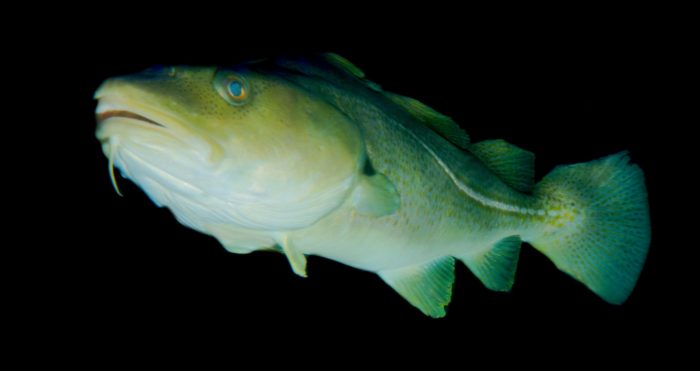
Sea Wonder: Atlantic Cod

Photo credit: Josh More
This week’s sea wonder is the source of Cape Cod’s name: the Atlantic Cod!
Appearance
These fish have large heads, heavy bodies, and whiskers similar to those found on catfish under their lower jaws. Cod are the only group of fishes in the world that we know to have two anal fins (on their underside near the tail) and three dorsal fins (on their backs). Their colors range from red and olive to yellow-green, with darker spots on the upper side of the body and a clear lateral line that runs lengthwise down each side of the fish. When fully grown, they can reach a length of up to 51 inches and a weight of up to 77 pounds.
The fish’s underside is lighter in color and usually free of spots. The darker back and lighter belly is common coloring scheme found in the marine environment called countershading, which provides the animal with protection through camouflage; when viewed from above the darker back blends into the depths below, and when viewed from below the belly blends into the light at the ocean’s surface.
Diet and Habitat
Atlantic cod have few predators in the food web, and most of them are large sharks. They feed on a variety of species, though, including smaller bony fish (and sometimes even younger Atlantic cod) lobsters, crabs, worms, and plankton.
These fish tend to live in coastal waters or slightly offshore. Atlantic cod live in the northwest Atlantic between Greenland to Cape Hatteras, North Carolina, which means we can find in Stellwagen Bank National Marine Sanctuary and possibly near Monitor National Marine Sanctuary. They are commonly found on Georges Bank and in the Gulf of Maine. Historically, cod were so abundant off the coast of New England that early explorers named Cape Cod after them.
Life History
Atlantic cod reproduce in the winter and early spring through spawning, where males and females release gametes into the water column at the same time. This species is highly productive as females can release millions of eggs at a time and nearly a billion in their lifetimes. So many eggs are produced and fertilized because the likelihood of reaching sub-adulthood and adulthood is quite small. Eggs and larvae are likely to be eaten by any number of species near the seafloor, including crabs, lobster, and other fish. Atlantic cod are reproductively viable around two or three years old.
Threats and Conservation
Atlantic cod is a historically overfished species due to high fishing pressure in the late 20th century, collapsing in the late 1990s, and remains below target population levels in both the Gulf of Maine and Georges Bank. To reduce fishing pressure and help with recovery, the National Marine Fisheries Service allows fishing of this species, but only in specific parts of their habitat at reduced levels and with minimum fish sizes. NOAA has rebuilding plans in place for both fisheries with a goal of repopulating by the mid- to late-2020s.
In the past, fishing occurred at higher rates than reproduction, leading to losses in population that compounded over time. With changes in target fish after the Cod fishery collapse, changes in the food web also affect these fish because it changes the prey available to them. Despite the current state of its population, NOAA’s National Marine Fisheries Service labels Atlantic Cod as a smart seafood choice because of its sustainable management.
